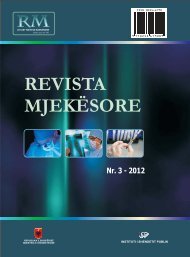in Albania - Instituti i Shendetit Publik
in Albania - Instituti i Shendetit Publik
in Albania - Instituti i Shendetit Publik
Create successful ePaper yourself
Turn your PDF publications into a flip-book with our unique Google optimized e-Paper software.
ALBANIAN MEDICAL JOURNAL SUPPLEMENTIod<strong>in</strong>e status among school-children <strong>in</strong> <strong>Albania</strong>Jolanda Hyska 1,2 , Iris Mone 31Faculty of Public Health, University of Medic<strong>in</strong>e, Tirana, <strong>Albania</strong>;2Institute of Public Health, Tirana, <strong>Albania</strong>;3Faculty of Medic<strong>in</strong>e, University of Medic<strong>in</strong>e, Tirana, <strong>Albania</strong>.Aim: Iod<strong>in</strong>e deficiency disorders (IDDs) arecurrently one of the major worldwide public healthproblems. IDDs rema<strong>in</strong> a public health concern <strong>in</strong><strong>Albania</strong> too. This survey was undertaken todeterm<strong>in</strong>e median ur<strong>in</strong>ary iod<strong>in</strong>e concentrationamong school children, and assess the level of iod<strong>in</strong>e<strong>in</strong> salt samples at the household level, after the<strong>in</strong>troduction of the use of iodized salt at nationallevel <strong>in</strong> <strong>Albania</strong>.Methods: A cross-sectional study was conducted<strong>in</strong>clud<strong>in</strong>g a representative sample of school-children(N=1060) aged 6-13 years. Ur<strong>in</strong>e and salt sampleswere exam<strong>in</strong>ed for iod<strong>in</strong>e concentration levels.Results: Overall, median ur<strong>in</strong>ary iod<strong>in</strong>econcentration was 100.4 mg/l, <strong>in</strong>dicat<strong>in</strong>g non iod<strong>in</strong>edeficiency;also, 49.6% of the ur<strong>in</strong>e samples exam<strong>in</strong>edshowed iod<strong>in</strong>e <strong>in</strong>sufficiency (2.4% severe IDD, 13.4%moderate IDD and 33.7% mild IDD, respectively).Iod<strong>in</strong>e content was found to be adequate <strong>in</strong> 62.1%of the salt samples. The median iod<strong>in</strong>e concentrationof salt samples was 18.5 mg/ l.Conclusion: Compared to the results of previoussurveys, the IDDs rates have decl<strong>in</strong>ed <strong>in</strong> the last fewyears <strong>in</strong> <strong>Albania</strong>. However, IDDs cont<strong>in</strong>ue to be animportant public health problem <strong>in</strong> <strong>Albania</strong>. Thesef<strong>in</strong>d<strong>in</strong>gs call for identification of factors to strengthenthe National IDD Control Program: the need to banproduction, trad<strong>in</strong>g and use of the non-iodized salt<strong>in</strong> <strong>Albania</strong>, and the need for repeated surveys tomonitor the progress <strong>in</strong> elim<strong>in</strong>at<strong>in</strong>g IDDs <strong>in</strong> <strong>Albania</strong>.Keywords: iod<strong>in</strong>e, iod<strong>in</strong>e deficiency disorders, school-children.86 ALBANIAN MEDICAL JOURNAL SUPPLEMENT




